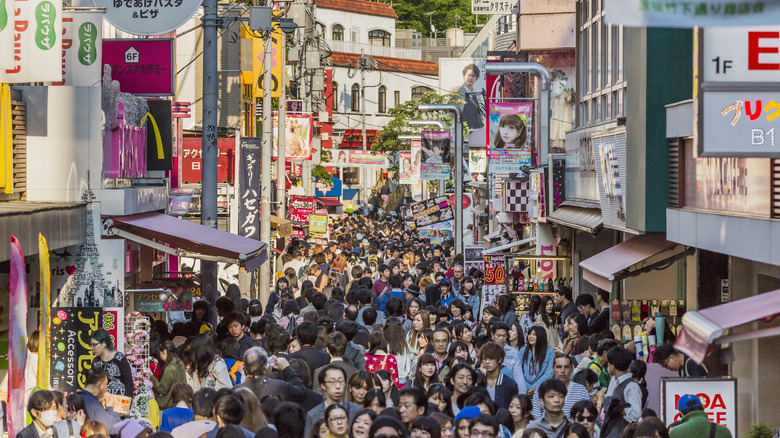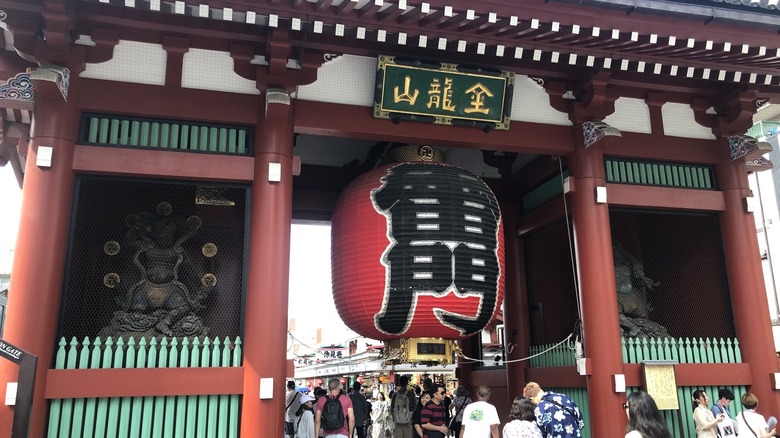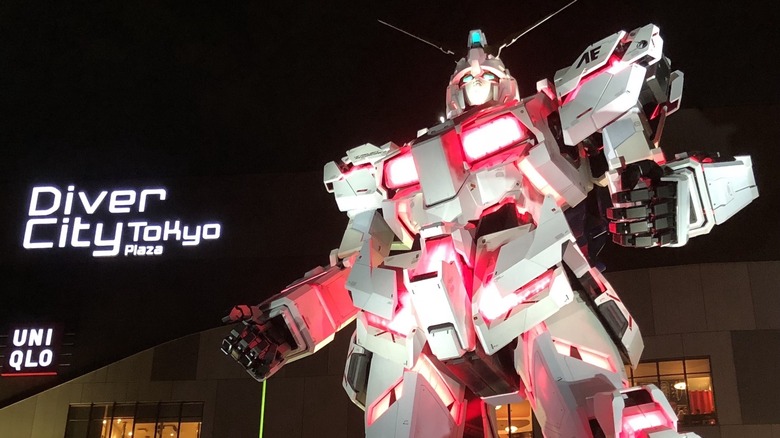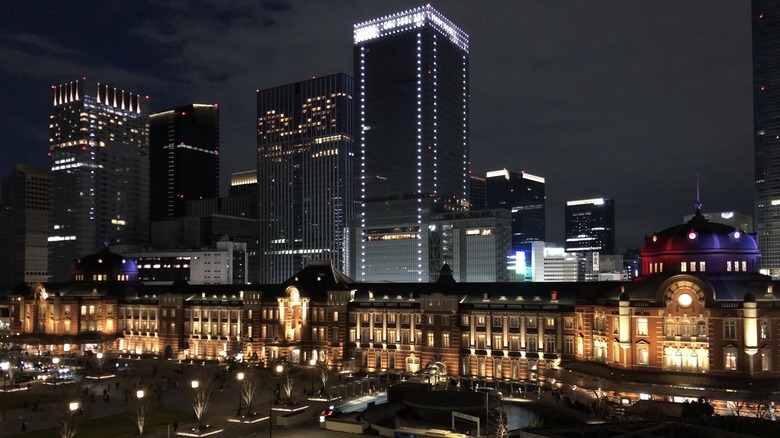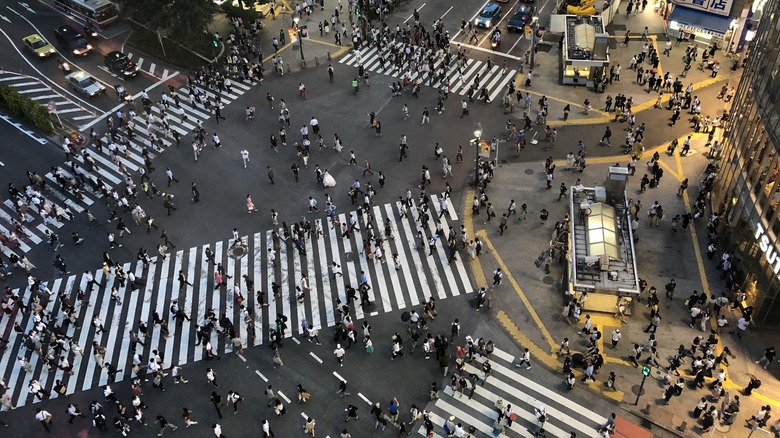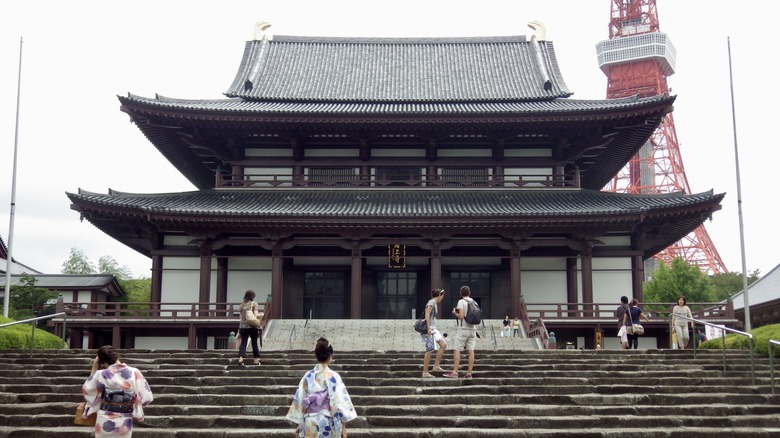The World's Most Populated City Is An Exciting, Albeit Crowded, Cultural Hub In Japan
When you're in a bustling pedestrian scramble or the world's busiest train station, you might feel like there's nowhere on earth more crowded than Tokyo. In a very real sense, you'd be right. While some sources list cities in China, like Guangzhou or Chongqing, as the largest on earth, the BBC has pointed out that the math with Chinese population statistics is sometimes off. This is because the "cities" in question are loosely defined, extending into rural areas that it would take a full day or two to traverse.
If you only count the true urbanized areas, which are within range for commuters, then experts cite Tokyo as the biggest city on the planet, home to a population of 37.4 million. What that really means is Greater Tokyo, where the vast urban sprawl stretches into Yokohama, a neighboring city that's just as fabulous as Japan's capital. Trains in the Tokyo-Yokohama corridor get even more jam-packed when you mix in record numbers of inbound tourists, year after year.
In some ways, Tokyo is more like a small state than a city, since it has its own governor, and it constitutes its own prefecture, one of 47 nationwide. The core of the metropolis is its 23 special wards, places like Shinjuku and Shibuya, which have different mayors. Each of these places could be considered a destination in and of itself. When I write my address, I write it as "Chofu-shi, Tokyo," with the "shi" denoting one of many other cities within the city. Even for a longtime resident, Tokyo is an endless horizon where new hotspots are always waiting to be discovered. Exploring the distinct neighborhoods that make up this megacity will immerse you in different pockets of culture—and of course, crowds.
Old meets new in Senso-ji Temple and Tokyo Skytree
Tokyo means "eastern capital," with the city, formerly known as Edo, receiving that name in 1868 when it took over from the western capital, Kyoto. As such, there's no better place to start a tour of Tokyo, perhaps, than the east side of town. In Asakusa and Sumida, you can see the traditional and modern juxtaposed with the city's oldest temple and its tallest tower. The temple is Senso-ji, and it dates to the year 645. Get there early if you want to avoid being photobombed as tourists crowd around the "Thunder Gate," Kaminarimon, posing for pics in front of the big red paper lantern that hangs over its entrance. Nakamise, the narrow shopping street that leads back to the temple's main hall, also creates a bottleneck that only gets thicker as the day goes on.
A few blocks away from Senso-ji is Kappabashi Kitchen Street, where you can shop for the kind of plastic food samples you'll see in Japanese restaurant windows. Just across the river is the 2,080-foot Tokyo Skytree, which holds the Guinness World Record for the tallest tower anywhere. The lines for its observation decks are longest in the mid-to-late afternoon and early evening, as people turn out to watch the sunset over Tokyo.
From the Azuma Bridge, you'll see the Skytree behind a cluster of buildings that includes the flame-topped Asahi Beer Hall and the mug-shaped headquarters of Japan's top-selling beer brand. To sip some of that beer yourself while looking out over the Sumida River, head to the Asahi Sky Room on the 22nd floor. Afterward, you can take a water bus down the river from Tokyo Cruise's Asakusa pier.
Escapist pleasures await in Odaiba and Tokyo Disneyland
You can ride a water bus all the way down the Sumida from Asasuka to a seaside park on the artificial island of Odaiba in Tokyo Bay. Stroll along the beach or boardwalk, and you'll have a view of the iconic Rainbow Bridge spanning the bay. The bridge also has pedestrian walkways, and true to its name, it does light up rainbow colors on special occasions, though you're likely to see it illuminated white most nights.
Inside Madame Tussauds on Odaiba, you'll find photo ops of wax figures like Japanese polka-dot artist extraordinaire, Yayoi Kusama. Outside the DiverCity Tokyo Plaza shopping mall, you can stare up in wonder at a life-sized statue of the giant anime robot, Gundam, in unicorn mode. The automated Yurikamome train connects it and the rest of Odaiba with Toyosu Fish Market, where you can watch a 5:30 a.m. tuna auction and eat fresh sushi or seafood bowls. The digital art museum, teamLab Planets Tokyo, is located just one stop from there. Together with teamLab Borderless across town, it gives Tokyo two of the world's most popular museums.
From Odaiba's Tokyo Teleport Station, it's a short ride to Shin-kiba, where the Keiyo Line will take you out to the two best-rated Disney parks in the world. The last stop before Maihama Station — your gateway to the always-crowded Tokyo Disney Resort — is Kasai Rinkai Park, where you can ride the Diamond and Flower Ferris Wheel and visit the Tokyo Sea Life Park aquarium. When you've seen enough and are ready to reenter the heart of the capital, the Keiyo Line will also transport you back to Tokyo Station.
Famous landmarks are in all directions of Tokyo Station
Tokyo Station, erected in 1914, is more than just a connecting hub for commuter trains and bullet trains. Bookended by twin domes, its red-brick facade is longer than the height of Tokyo Tower, and it houses a unique luxury hotel that serves as a pocket of tranquility in a station teeming with passengers. A number of famous sights are within walking distance of the station as well. That includes the Imperial Palace grounds, an atypically wide, uncrowded space in Central Tokyo, where castle turrets and swans grace the moat that surrounds the Japanese emperor's residence.
On the other side of the station is Nihonbashi, where a historic bridge with the kilometer-zero marker for Japan leads across a canal to the country's first department store, Mitsukoshi. Between it and the Ginza shopping district is the Tokyo International Forum, an architectural marvel where elevated walkways crisscross a ribbed atrium shaped like a glass cruise ship. Equally Instagrammable are the colorful goldfish installations in the nearby Art Aquarium Museum. It's in Ginza, where you'll find many of the fine-dining establishments that make Tokyo the city with the most Michelin-starred restaurants in the world.
The Chuo-Sobu Line runs through other parts of Central Tokyo, like Akihabara, a mecca for electronics and otaku culture. Ryogoku provides access to both the national sumo arena, the Kokugikan, and a treasure trove of local history at the Edo-Tokyo Museum (set to reopen in 2026). In Suidobashi, you can escape the hustle and bustle of the city in the peaceful landscape garden, Koishikawa Korakuen. Or you can opt for thrills with a midtown roller coaster ride through Tokyo Dome City.
Shinjuku and Shibuya offer bright lights in the big city
While the JR Yamanote Line loops around the capital, the Chuo Line cuts across it from Tokyo Station to Shinjuku. Your lodging options there include the Hotel Gracery Shinjuku, where a life-size Godzilla head looks out over the neon signs of the Kabukicho red-light district. The back alleys of Golden Gai are littered with hole-in-the-wall bars, or you can squeeze into a stall for grilled chicken skewers in nearby Omoide Yokocho. West Shinjuku is the skyscraper district, where the twin spires of the Tokyo Metropolitan Government Building offer two free observation decks with 45th-floor views.
Through Shinjuku, you can link up with the Tama region, where the Ghibli Museum, the Hello Kitty theme park, Sanrio Puroland, and the hiking destination, Mt. Takao, are situated. The next ward over is Shibuya, where pedestrians swarm the city's well-known Scramble Crossing. Two places where you'll get an elevated view of the crossing (another beacon of neon at night) are the 8-story Magnet by Shibuya 109 and the 47-story Shibuya Scramble Square. Both sport rooftop observatories, with the latter offering a more expansive, panoramic view of the Tokyo skyline.
Shibuya extends to Harajuku Station, which lets out near two of Tokyo's most crowded shopping streets, Takeshita Dori and Omotesando. The former peddles crepes and kawaii fashion: the latter deals in luxury brands. More spacious and less congested are the adjacent Meiji Shrine and Yoyogi Park, where you can commune with nature and take a breather from the undulating sea of human heads. The leafy green shrine is dedicated to Japan's first emperor, while the park is a great place to see vibrant yellow ginkgo trees and other fall colors.
Can't-miss sights like Tokyo Tower dot the Oedo Line
The only Tokyo subway line that's completely underground is the Toei Oedo Line, which circles around from Shinjuku Station to its west gate ("nishiguchi") before heading out to Toshimaen. The former Toshimaen amusement park site is now occupied by the biggest Harry Potter attraction in the world, The Warner Bros. Studio Tour Tokyo. Elsewhere along the Oedo Line is Ueno, where a zoo with pandas, a pond with pedal boats, and multiple museums, temples, and shrines all converge on one sprawling park.
Further down the line is Tokyo's deepest subway station, Roppongi, which leads to the National Art Center and the Mori Art Museum in Roppongi Hills. You can reach the Japan Olympic Museum via Kokuritsu-Kyogijo (National Stadium) Station. Over in Daimon, you can walk to Tokyo Tower, framing snapshots of it against the main hall of Zojo-ji as you pass through the temple's ancient grounds. The next two stations serve Nittele (short for "Nippon Television") Tower and the remnants of the old fish market, Tsukiji. For sightseers, the main draw of the tower might be its steampunk clock sculpture designed by animation legend Hayao Miyazaki.
Though it's not on the Oedo Line, Tennozu Isle is another good place to see public art, and it's where you can catch the Tokyo Monorail out to Haneda Airport. To view more marine life in Tokyo, including dolphin shows and an outdoor aqua ring populated by sea lions, head to the aquariums in Shinagawa and Ikebukuro's Sunshine City. Places like Yanaka Cemetery and the Meguro River, meanwhile, rank among the best spots to view cherry blossoms in Japan.
